Among the many cakes, the Chiffon Cake is considered the most challenging to bake. Conceived by an American salesman in the early 1940's, this dessert is no ordinary cake. To put it bluntly, this a hybrid of two cakes: a sponge cake and an oil cake; the former usually omits any form of fat from its batter but the chiffon cake requires it for the extra moistness and richness.
This means a typical recipe might rely not only on whipped egg whites but also baking powder for leavening. That and it must be baked strictly in a clean, ungreased pan to ensure it has the best rise. Finally, when baking is done, the cake pan must be inverted so that gravity can keep it fluffy. Given how bizarre it sounds, it's easier to see why this particular dessert can be awfully tedious to bake. However, as long as the baker is willing to fully commit to some very strict rules, they could pull this off even on one try.
Most recipes for chiffon cake include citrus flavoring; usually juice and zest are supplied from fruits like orange and lemon.
However, what's special about the following recipe is that it calls for the extract of a blood orange. This crimson-colored mutation found across Europe has a distinctively sweet yet slightly bitter flavor that will prove interesting for this dessert. For the glazing, this recipe includes a simple icing flavored with the same extract.
Blood orange variant recipe
Cake ingredients:
- 2 cups cake flour, sifted
- 1/2 cup blood orange juice
- 1/4 cup cold water
- 1/2 cup vegetable oil
- 1 1/2 cup castor sugar
- 1 cup egg whites
- 1/2 cup egg yolks
- 1/2 tsp salt
- 1 tbsp baking powder
- 1 tsp blood orange zest
- 1 tsp vanilla extract
- 1 blood orange, sliced for garnish
Icing ingredients:
- 1 cup confectionary sugar
- 1 tsp vanilla extract
- 1/4 cup blood orange juice
Cake directions:
- Preheat an oven to 160°C. Separate the dry ingredients from the wet ingredients and separate the egg yolks from its whites. Sift the flour, salt, baking powder and half of the sugar together in a bowl. In another bowl, whisk together the juice, water, zest, oil, and egg yolks. Combine the dry ingredients with the wet ingredients in a larger mixing bowl.
- In a clean bowl, beat the egg whites on medium speed until they form soft peaks. Gradually add the remaining sugar while beating until the egg whites form stiff (but not dry) peaks. Do not over beat.
- Using a whisk, fold a third of the egg whites into the mixture gently until fully incorporated. Do not stir. Repeat with the remaining egg whites to complete the batter.
- Tap the bowl containing the batter on a flat surface a few times to knock out any bubbles that accumulate at the bottom. This ensures no holes form in the cake when it rises during baking. Slowly pour the batter into a clean, ungreased 10" tube pan. Bake in the oven for approximately an hour or until the top of the cake begins to crack and an inserted toothpick comes out clean.
- Remove the cake immediately and invert it on a cake rack or the neck of a wine bottle. Do not remove the cake until it completely cools. To remove the cake, use a sharp knife or offset spatula to remove the cake from the pan. Keep the knife or spatula as close as possible to the sides of the pan to avoid damaging the cake.
Frosting directions:
- To make the frosting, place the confectionary sugar, juice, and vanilla extract into a bowl and whisk until fully incorporated.
- To apply the frosting, slowly pour a line around the center of the surface of the cake to form a ring and use the spatula to spread it completely across it.
- Store and chill the cake until ready or serve immediately, garnish with the blood orange slices placed on top of the surface in a circle.
